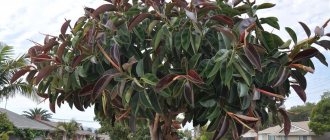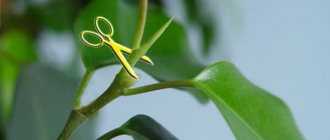Reproduction methods
There are the following methods of propagating ficuses: apical and stem cuttings, cuttings with one leaf and air layering. Small-leaved Benjamin ficuses are not propagated by cuttings with one leaf, as this is very difficult due to the small size of such cuttings.
Apical cuttings
During spring pruning of the tree, cut off upper parts of the shoots are formed, which can be rooted and young ficuses are obtained.
The cuttings should be more than 15 cm in length and have 2-4 large leaves. The branches from which they were cut should be semi-lignified.
To prepare a ficus cutting for rooting, you need to cut its lower part at an angle of 45º as close to the node as possible . The lowest leaf growing from this node is cut off with a knife, the remaining leaves are cut in half.
Prepared cuttings are placed in water for several hours so that the white juice does not solidify on the cut and interfere with root formation. After this, the cuttings need to be dried in air for 2-3 hours. Then they are rooted in one of 2 ways.
Methods for rooting cuttings
Ficus cuttings can be rooted in water or soil. The first method is the simplest. The cuttings are placed in a container with boiled water at room temperature so that their lower node is in the water. It is better to choose a container that is opaque or made of dark glass, so that blue-green algae, which prevents root formation, do not multiply in the water.
When rooting cuttings, it is necessary to maintain a temperature above 25ºС . High air humidity promotes rapid rooting. Usually roots appear within 3-4 weeks. When they lengthen to 4-5 cm, the cuttings can be planted in the ground.
Cuttings are often rooted directly in the soil. To do this, you can take a standard soil mixture for ficuses, which contains turf and leaf soil, peat and sand in a combination of 4:4:2:1.
Cuttings also root well in a mixture of peat and sand in a 2:1 ratio. For rooting you need a container with moist soil.
Ficus cuttings are buried into the ground by 1 node and covered on top with plastic wrap or glass jars. The substrate must be moist, and the air temperature during rooting should not be lower than 25ºC.
In such conditions, in about a month, young leaves will appear on the cuttings. After this, you can gradually remove the film from them so that they get used to the air humidity in a city apartment. When the cuttings actively begin to grow, they are transplanted into separate pots.
Stem cuttings
A long cut ficus shoot can be cut into pieces with 3-4 leaves.
These stem cuttings can also be rooted. They are prepared in the same way as apical cuttings, cutting off the lower part at an angle and drying the cut in air. Roots on stem cuttings form much more slowly than on apical cuttings , and many stem fragments do not form roots and disappear.
To increase the number of rooted stem cuttings, you can use drugs to improve root formation. If rooting occurs in water, the cuttings are soaked in a solution of the drug. If they are rooted in the ground, you need to powder the cut with stimulating powder.
Propagation by cuttings with one leaf
Thick shoots of rubber plants can be cut into short pieces with one node and one leaf.
The lower cut of such cuttings is made at an angle in the middle of the lower internode, the upper cut in the middle of the upper internode. The ficus leaf is rolled into a tube and secured with an elastic band or adhesive tape.
Prepared cuttings with one leaf are rooted only in the ground . They are buried in damp soil up to the petiole of the leaf. The temperature for rooting them is the same as for rooting other cuttings. To create constant air humidity, the container with the cuttings is covered with film.
Formation of air layering
An aerial layer is a part of a ficus shoot with formed aerial roots, which can be cut off and planted in the ground.
To form aerial roots, make 2 circular cuts on the ficus branch at a distance of 1-2 cm from each other . The bark between them is carefully removed, and the bare area is sprinkled with rooting powder.
Preparatory procedures
Flower growers and lovers of home crops choose ficus plants due to the fact that this flower is completely unpretentious in care and does not require specific conditions.
Before planting a ficus, preparatory procedures are carried out that are of great importance for the success of the operation.
Planting a ficus developing from a shoot is considered safe and easy to perform. At the initial stage, you will need a clean, sharp tool, such as a knife or blade, or an open vessel with warm water.
The selected shoot must have one or more viable buds and leaves, which is the key to successful completion of the procedure. Seating is carried out preferably in the spring and summer, since conditions at these times of the year are most favorable. A cutting is cut from an adult and completely healthy bush. It is important to know that its size should not exceed 15 cm. The cut is made at an acute angle.
Important! Making a cut with scissors or trying to carefully break the shoot will lead to a long recovery of the flower, as well as slow rooting of the new plant.
The cut shoot is placed in a container with water for 1.5–2 hours. After this, the sections are sprinkled with charcoal powder or treated with special antiseptics.
In addition to installing the cuttings in water, the following method is also practiced. The small tops of a flower, for example, ficus benjamina, are wrapped at the base in cotton swabs soaked in water and a mixture of fertilizers. These structures are installed in a saucer with a small layer of water. The cutting can remain in this position for a long time until the first roots appear. Next, it is strengthened in a pot.
Bald ficus benjamina: how to help grow rich leaves again
Want to help your pet become beautiful and green again? Small changes in care will help. Yes, Ficus Benjamin is good for everyone, except for one small feature that consistently upsets flower growers around the world. As soon as the plant doesn’t like something, it will immediately and categorically let you know by defiantly throwing off some of the leaves or completely reducing itself to the state of branches.
.
But the sad process is reversible for the ficus. Practice has shown that after dropping even 95% of the crown, the bush can become fluffy again. After reading the article to the end, you will learn how to turn back the “rivers.”
Representatives
If we talk about well-known representatives of the family, then most often they grow:
- Ficus benjamina. A favorite of all gardeners. An unpretentious decorative leaf plant. In the natural environment it can grow up to 8 m, at home - up to 2 m with impeccable care. The leaves of the bush are small - light, dark green or variegated, depending on the variety. Characterized by rapid growth.
Transplantation: new soil will give the ficus new nutrition
The second half of winter and March are the best times to replant most indoor plants. It is needed if the roots of the ficus have already begun to peek out from the drainage hole of the pot or the soil has begun to dry out too quickly.
Young ficus trees are replanted once every 1-2 years. As the roots entwine the earthen lump. Adult specimens - once every few years.
Careful transshipment, preserving the earthen clod entwined with roots, and adding new soil will provide the plant with nutrients
. And the new pot is a place for roots to grow.
Advice from the author
: If you do not have the opportunity to transship, simply renew the top layer of soil
Caring for young plants
Despite all the unpretentiousness and endurance of ficuses, in order to grow a healthy, beautiful tree from a cutting, it is necessary to take into account certain features of caring for a young plant.
The soil
Adult ficus prefer dense soil, and seedlings require light, mineral-rich substrates with a neutral or slightly acidic pH. A mixture of leaf soil, peat and sand, taken in equal parts, is best suited. A drainage layer of expanded clay or small river pebbles must be laid at the bottom of the planting container.
Important: In the first days after planting the cuttings, the soil temperature is maintained at an elevated level; for this purpose, the pots with plants are raised above floor level.
Choosing a location and lighting
Almost all ficus trees are shade-tolerant. Pots with trees do not have to be placed on the windowsill. It is optimal to plant the seedling at a distance of 0.7-1.5 m from the southern, western or eastern window in a bright place, but protected from intense direct rays of the sun and drafts. In the dark season, additional lighting is desirable.
When choosing a location, we take into account varietal characteristics:
- ficuses with hard, leathery leaves (rubber-bearing) easily tolerate bright light;
- variegated varieties are more demanding of light, they need good, long-lasting lighting, otherwise the color of the leaves fades and the plant loses its decorative effect;
- hanging, creeping, rooting, low-growing varieties prefer partial shade;
- ficus benjamina prefers abundant light and does not like rearrangements.
The favorable light level for ficuses is 2600-3000 lux.
Humidity mode
Young plants rooted under cover and in water require a lot of moisture. Trees planted in a permanent place are regularly sprayed. Adult plants, with the exception of lyre-shaped and tiny creeping plants, do not need high air humidity, although in hot weather and in winter with the heating on, spraying and a warm shower will not hurt.
Required watering
Watering mode:
- in summer - regular and abundant (until it flows out of the drainage hole);
- excess moisture in winter is dangerous for the roots, they can rot, so in winter the amount of watering is reduced to once every 10 days;
- if the soil in a pot with a young plant has dried out by 2-3 cm, it’s time to water; the plant dropping its lower leaves indicates an excess of moisture.
Required temperature
Young plants, accustomed to greenhouse conditions, are gradually accustomed to lower temperatures, lowering the room temperature by 1-2 degrees every week. In summer, a temperature of 18-25 °C is considered comfortable, in winter - 13-20 °C. We mean that variegated ficuses are more thermophilic. For them, the temperature is maintained 3-5 °C higher. Carian (fig) and tiny ficus, on the contrary, love coolness; for them, the temperature in winter can be reduced to 10 °C.
When and how to fertilize
The trees are fed for the first time 1-2 months after planting. No fertilizing is required in winter. In warm weather, plants are fertilized once every 2 weeks. It is more convenient to use ready-made complex fertilizers (Ideal, Bona Forte, Rainbow, Pockon).
Transfer
Young ficus trees are replanted every year as they grow, preferably in the spring. The need for replanting is easy to notice by the rapid drying of the soil and the clod of soil heavily entwined with roots. When choosing a new container for planting, they adhere to the rule - its diameter should be one and a half to two centimeters larger than the diameter of the previous pot.
Throwing away pity: life-giving pruning
New leaves will no longer grow in place of fallen leaves. But leaves will appear on young shoots. To stimulate the growth of new branches from the buds, you can do simple pruning.
I cut all ficus branches affected by botanical alopecia exactly in half
. At the same time, out of 2 shoots growing close and parallel to each other, I leave one. So that they don't interfere with each other. If something grows inside the bush, you can also cut it off: this way the entire bush will be well illuminated by the sun.
Briefly about watering
Overwatering a ficus is much more dangerous than drying it out. Moreover, a sad rule works: the fewer leaves, the smaller the area for moisture evaporation. Therefore, bald Benjamin needs very, very careful and meager watering! Be sure to ensure that the top layer in the pot dries completely.
For obvious reasons, it is better to postpone watering from the shower. But spraying and wiping the surviving leaves will be beneficial.
Author's advice
: A “hot shower” for a bald ficus can awaken dormant buds. But you need to water so that almost no water falls on the ground. For example, tilting a pot.
The most important thing is the weather in the house
I’ve probably already tired you with a long text, although I tried to write only the most important things. Now, in a short list, I will list the ideal conditions for the growth of new branches and leaves of Ficus Benjamin:
- sunny window (especially important for variegated varieties);
- absence of cold drafts - while the temperature outside is low, try to move the pot away from the glass;
- You should not constantly rearrange and twist the plant - to ensure that the crown grows evenly, periodically turn the pot a few degrees.
I hope that my tips will help your ficus regain its former beauty. Do you love The Benjamins and was the article helpful? Please give her a thumbs up in return! Thank you
.
And owners of other decorative foliage flowers may find this article useful: Zamioculcas does not tolerate: common mistakes of beginners
When can ficus benjamina be propagated?
Ficus is one of the popular house plants used to decorate the interior. Intensive growth of shoots and bright green foliage will transform a room for any purpose. Culture looks great in a small apartment and a large country house. This exotic beauty won the hearts of flower growers not only with its high aesthetic qualities, but also with its undemanding care. The culture also has beneficial properties, which are expressed in the ability to purify the air from dangerous chemical compounds (benzene, trichlorethylene, phenol, etc.).
The flower is easy to propagate using one of the available methods. It is better to plan these events for spring or summer. In autumn there begins a period of rest. Until spring comes, the plant rests and gains strength. At this time, the production of new shoots and foliage is reduced. You should not injure the ficus by cutting cuttings or leaves; there is a high probability of weakening the protective function.
Reference! The favorable time for transplanting ficus is considered to be the period from May to August.
Reproduction methods
Ficus benjamina can be propagated using one of the possible methods.
Cuttings
This method involves the use of lignified shoots. The length of the workpiece should be 10-15 cm. If the cutting is a little lower or higher, it’s not a big deal. When planting a thin base, you will need to install a support.
Cut shoots should be placed in water. While the cuttings are cleared of milky juice, you should choose a rooting method. The milky juice should be removed by soaking the cut. If it is left on the cutting, the frozen crust will interfere with the formation of roots and new shoots.
By layering
If the plant produces a small increase in shoots, you can use the layering method to propagate the ficus. To get a new flower, follow these steps:
- On the mother plant, a shoot 40-50 cm long is selected.
- The place where it is planned to grow roots is marked on it.
- Remove 2-3 sheets in the selected area.
- Make two circular cuts in the bark, keeping an interval of up to 3 cm between them.
- Remove the bark in the intermediate area.
- Apply Kornevin to the exposed part of the shoot.
- Fix sphagnum moss in this place and moisten it with a spray bottle.
- Cover this area with a strip of polyethylene and secure the twist with threads.
- Periodically check the moisture level of the moss. If necessary, it is sprayed with warm water.
- After root branches appear around the moss, the cuttings are cut below the level of the root system.
- The resulting layering is planted in a separate pot. And the place where the mother plant is cut is treated with a solution of activated carbon and wax.
The process of obtaining layering takes approximately 2-2.5 months. If you follow the moisturizing regime, the result is always positive.
Leaves
This method is only called leaf, but to harvest planting material, a leaf plate with a petiole and a small part of the stem are required.
The first cut is made under the bottom leaf. Make a 1 cm indent from it. Then 1 cm indent from the cut line and make a cut off again. The next cut is made above the second leaf. As a result, you get as many blanks as there are cut fragments with leaves.
After soaking the cuttings to remove the milky juice, they are buried in the soil mixture. Choose a pot that is spacious enough to accommodate all the cuts. Drainage is introduced into the bottom of the container in a layer of 3-4 cm. The substrate is chosen to be light and loose. The most successful option is a composition based on peat and fertile soil. The shoots are buried in the soil to the base of the petiole.
The blanks should be placed along the edge of the container so that the sheet tilts slightly over the sides. For quick rooting, the planting is covered with polyethylene or a glass vessel and moistened periodically. The process of forming the root system takes approximately 2-3 months. After this, the young plant can be replanted.
Seeds
You can even grow ficus benjamina using seeds. They are very small, so they use a magnifying glass and a wooden stick for sowing. The period favorable for germination of planting material falls in February - April. In the absence of heat, the time is extended until July.
Reference! During the process of growing seedlings, artificial lighting may be required to increase daylight hours (it should be at least 10-12 hours).
For planting, choose a shallow container, which is filled with a mixture of sand and turf soil. The substrate is not filled to the edges (the sides are left 3-5 cm). The surface of the soil mixture is moistened with warm water from a sprayer. Lightly pat down the improvised bed with the palm of your hand.
Place seeds onto the prepared substrate with a stick, trying to distribute them evenly throughout the container. To keep the grain on the edge of the stick, it is first moistened in water.
The planting is sprinkled with fine-textured soil, creating a 3 mm layer. To retain moisture in the soil, a polyethylene frame is installed on the top of the container. In a greenhouse environment, seedlings should appear after 5-8 weeks.
Rooting
In order for the ficus shoot to produce roots, it is placed in water or in the ground. If you choose the first option, then to improve the conditions under which roots appear, nutritional supplements that stimulate growth are added to the water.
For planting, choose a small container and immerse a smaller part of the shoot in it. Experienced gardeners recommend applying a small amount of honey to the submerged area.
To avoid rotting of the submerged shoot, dissolve 1 tablet of activated carbon in water.
When choosing to grow roots in an earthen environment, first also keep the cutting in a container of water for several hours.
The pot where the cutting will be planted is chosen to be small, with a good drainage system and holes for air circulation. As the root system grows and the overall growth of the flower, transplants are carried out to increase the volume of the pot.
The mixture can be purchased at a specialty store. Many gardeners prepare it themselves.
The following components are usually used:
- Peat;
- Sand;
- Perlite;
- Vermiculite;
- Expanded clay.
This composition guarantees moisture capacity and good aeration of the root system. Perlite is poured into the pot where the cutting will be planted, and then soil is added. Select a slightly damp mixture. Then a recess is made, the depth of which varies depending on the length of the cutting. The shoot is strengthened to the level of the first leaf on it.
Ficus should be planted in moist soil. The shoot is placed on the ground and covered with earth. In some cases it is necessary to install a support.
Planting ficus trees does not seem to be a complicated procedure, but neglect and carelessness should not be tolerated.
How to do it right
First you need to prepare everything you need. Do not forget about disinfection of the products used.
Required materials and tools
In the process of preparing cuttings you will need:
- mother plant;
- container;
- filler;
- container with water;
- pruning shears or sharp knife;
- alcohol solution or other disinfectant;
- root stimulator.
Step-by-step instruction
It is easier to complete the work of harvesting and rooting cuttings if you follow this sequence.
- First stage. Select lignified or semi-lignified shoots on the mother plant, the length of which reaches 5-15 cm. They should have 2-3 nodes. You can take cuttings from both the top and side branches.
- Second phase. Make an incision with pruning shears under the lower bud. In this case, the pruning shears are installed at an angle of 45°. Cuttings should be treated with a product that activates the development of the root system (for example, Kornevin). This will speed up the rooting process.
- Third stage. To remove the milky juice released at the cut site, you need to place the cuttings in a container with warm water. Soak the workpieces in the liquid for an hour.
- Fourth stage. Fill the container with sand or a mixture of peat and perlite. Other fillers are also suitable: perlite, vermiculite, sphagnum moss. After lightly moistening, plant the cuttings in a container.
- Fifth stage. The container is covered with a glass jar or glass. The workpieces are kept in a warm room at a stable temperature of 25-26°. Periodically, the filler is slightly moistened. After 2-3 weeks, the cutting produces thin root shoots.
Fertilizers, fertilizing, stimulation
After the initial period of the rooting process, structural changes begin in the shoot, which affect several outer layers of tissue. Experienced gardeners recommend making 2-3 small cuts on the part of the cutting that will be immersed in the ground. This accelerates the development of the young root system.
In addition to physical methods of stimulating root growth, there are also chemical ones. These include various types of fertilizers and fertilizers that are used to improve the functional state of flower tissues.
You can soak the lower part of the shoot in a fertilizer solution for several hours, and then strengthen it on the ground. You can also apply powdered fertilizer to the cut instead of ash. This local application gives excellent results.
Features of reproduction
Instruments used to work with the plant must be sterile. To do this, the cutting part is treated with an alcohol solution or other antiseptic. If cuttings are taken from different bushes, then disinfection must be carried out after each flower. This will prevent infection of healthy flowers.
In the ground
For rooting in the ground, a substrate is prepared from turf soil, sand and peat. All components are disinfected in the oven by heating. After this, they are mixed and introduced into the planting container.
Reference! Small pots are suitable for rooting 1-2 cuttings. If there are more blanks, it is better to use a rectangular container with appropriate parameters.
After cleaning the milky juice, the shoot is buried into the soil mixture by 2-3 buds. The soil is lightly compacted and moistened using a sprayer. To create a greenhouse effect, sticks are placed along the edges of the container, and a transparent plastic bag is fixed on top of them. The frame should be higher than the planting material. Successful rooting requires a warm environment and moderate humidity.
In water
Rooting cuttings in water is considered less troublesome. It is enough to place the blanks in a container with liquid. The container should not allow light to pass through, so when using a glass vessel, gardeners wrap the outer wall with foil or thick dark fabric. It is also necessary to build something similar to a greenhouse on top of the cuttings. The simplest option involves fixing a plastic cup.
When the cuttings are rooted in water, the microclimate is established close to the natural habitat conditions of ficus trees. This is a temperature within 25° and an average level of humidity.
Maintenance of an improvised greenhouse is kept to a minimum:
- 2-3 holes are made in the bottom of the plastic cup for free passage of air;
- As the water evaporates, make gravy;
- After the roots appear, the structure is dismantled for subsequent transplantation of the shoot.
Rules and requirements for breeding
To propagate rubber ficus, you must adhere to some generally accepted recommendations.:
- Experienced gardeners recommend propagating the plant exclusively in warm weather. The optimal period for this operation is spring or warm autumn.
- Ficus should be placed on window sills without direct sunlight, since they suffer from ultraviolet radiation, especially young leaves are susceptible to its harmful effects.
- When cutting a cutting, you need to get rid of the milky juice by holding it under running water.
- For propagation, you need to use only woody shoots; unlike young shoots, they will be able to produce roots.
- To root a cutting, you can use both the upper part of the stem and those parts that have more than one node.











